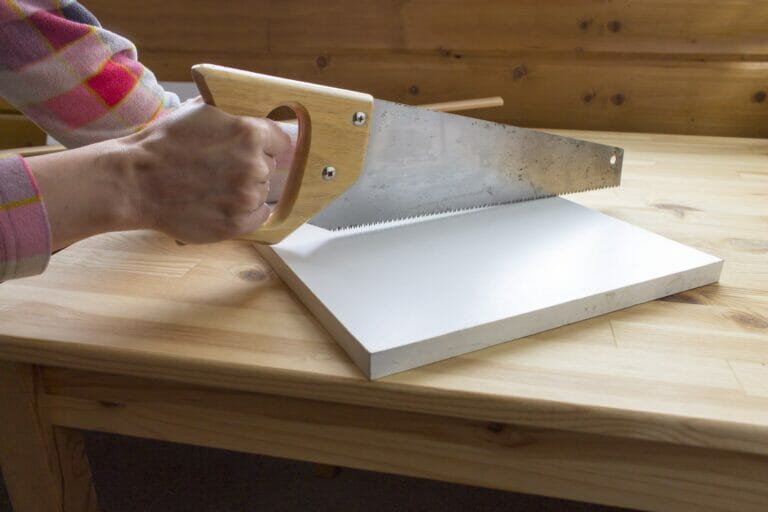
When it comes to woodworking, one of the biggest decisions you’ll face is choosing between a hand saw and a table saw. So, Hand Saw vs. Table Saw, which one should you go for? Well, let’s dive in and explore the pros and cons of each to help you make an informed decision.
First up, the hand saw. This classic tool offers precision and control, allowing you to make intricate cuts with ease. With a hand saw you have the freedom to move around and work in tight spaces that may be difficult to access with a table saw.
Plus, there’s something satisfying about the tactile experience of using a hand saw and feeling the wood yield to your skillful strokes. But, as with anything, there are drawbacks too.
Now, let’s switch gears and talk about the table saw. This powerful machine is a carpenter’s best friend when it comes to handling larger projects and heavy-duty cutting tasks. Its stationary design provides stability and accuracy, making it ideal for straight and long cuts.
With a table saw you can save time and effort, as it can handle repetitive cuts with ease. However, keep in mind that a table saw requires a dedicated workspace and some safety precautions.
So, whether you opt for the versatility of a hand saw or the precision of a table saw, it ultimately depends on your needs, project requirements, and personal preferences.
Now, let’s delve deeper into each option and discover the world of cutting tools in woodworking!
Comparing Hand Saw vs. Table Saw
- Portability: Hand saws are lightweight and portable, making them ideal for job sites or outdoor projects. Table saws, on the other hand, are stationary and offer a larger working surface.
- Cutting Capacity: Table saws generally have a higher cutting capacity and can handle larger and thicker materials compared to hand saws.
- Accuracy: Table saws offer precise and consistent cuts due to their stationary nature and adjustable fences.
- Versatility: Hand saws are versatile and can be used in various cutting applications, while table saws excel at making straight cuts.
- Safety: Table saws often come with safety features like blade guards and anti-kickback mechanisms, providing enhanced safety during operation.
Overview of Hand Saw
The hand saw is a classic tool that has been used for centuries. Its simple design consists of a handle attached to a flat metal blade with teeth.
Hand saws are available in various lengths and tooth configurations, allowing you to choose the right one for different types of cuts. They are lightweight, portable, and do not require electricity, making them ideal for small projects or when working in remote locations.
Overview of Table Saw
Unlike the hand saw, the table saw is a stationary power tool that consists of a circular saw blade mounted on an arbor that is driven by an electric motor.
It is designed to be placed on a table or workbench, hence its name. The table provides a stable surface for cutting large sheets of wood or making precise cuts.
Table saws come with various features such as adjustable cutting angles, rip fences, and miter gauges, making them highly versatile and suitable for both small and large woodworking projects.
Key Features Compared
Now let’s dive into the key features of the hand saw and the table saw and compare them side by side.
1. Cutting Capacity
The hand saw is best suited for smaller woodworking tasks, such as cutting boards or trimming pieces of wood. Its cutting capacity is limited by the length and thickness of the blade.
In contrast, the table saw offers a much larger cutting capacity, allowing you to make long, straight cuts on larger pieces of wood or even cut through thick plywood or hardwood with ease.
2. Precision and Accuracy
When it comes to precision and accuracy, the table saw takes the lead. Its stable and adjustable table, along with features like rip fences and miter gauges, ensures that your cuts are straight and precise every time.
On the other hand, using a hand saw requires excellent hand-eye coordination and skill to achieve the same level of precision.
3. Versatility
While the hand saw is limited to manual cutting, the table saw offers a wide range of cutting options. With a table saw, you can make rip cuts, cross cuts, miter cuts, bevel cuts, and even dado cuts.
This versatility makes the table saw a go-to tool for professional woodworkers who need to tackle complex projects that require different types of cuts.
User Experience
The user experience with both the hand saw and the table saw differs significantly. Using a hand saw requires physical effort as you have to manually cut through the wood by applying force.
It is a slower process and may require more time and patience to achieve the desired results. On the other hand, the table saw’s electric motor makes cutting effortless and saves time.
However, it also requires a certain level of expertise and caution to operate safely due to the spinning blade.
Pros and Cons
Hand Saw:
Pros:
– Portability: This can be taken anywhere.
– Quiet operation: No noise from the electric motor.
– Low cost: Hand saws are generally more affordable than table saws.
Cons:
– Limited cutting capacity: Not suitable for large or thick materials.
– Requires physical effort: Can be tiring for longer or complex cuts.
– Less precision: Achieving precise cuts may be more challenging.
Table Saw:
Pros:
– Large cutting capacity: Can handle big and thick materials.
– Precise and accurate cuts: Features like rip fences and miter gauges ensure precise cuts.
– Versatile: Can perform various types of cuts.
Cons:
– Expensive: Table saws can be costly compared to hand saws.
– Requires electricity: Not suitable for remote locations without power supply.
– Safety concerns: The spinning blade can be dangerous if not used carefully.
Price Comparison
When it comes to price, hand saws are generally more affordable than table saws. A good quality hand saw can range from $20 to $50, depending on the brand and features.
Table saws, on the other hand, can range from $300 to $2000 or more, depending on the size, motor power, and additional features.
Which is Better – Hand Saw vs. Table Saw?
After considering the key features, pros and cons, and user experience of both the hand saw and the table saw, the answer to which is better ultimately depends on your specific woodworking needs.
If you are a hobbyist or work on small projects occasionally, a hand saw might be sufficient for your needs. Its portability, affordability, and simplicity make it a practical choice.
However, if you are a professional woodworker or regularly undertake complex projects that require precise cuts, the table saw would be the better option.
With its larger cutting capacity, versatility, and ability to deliver accurate cuts consistently, the table saw offers efficiency and convenience.
In summary, both hand saws and table saws play important roles in woodworking, and the choice between them depends on your specific requirements. Consider the scale of your projects, the level of precision needed, your budget, and the time and effort you are willing to invest.
Frequently Asked Questions
Welcome to our Frequently Asked Questions section, where we compare hand saws and table saws. Here, we’ll address some of the common questions people have when deciding which type of saw to use for their projects. Read on to get a better understanding of the differences and advantages of each.
1. What are the main differences between a hand saw and a table saw?
A hand saw is a manual tool that requires physical effort to cut through materials, while a table saw is a power tool that uses a motor to spin a circular blade. Hand saws offer more flexibility and portability, but table saws provide greater precision and power.
Hand saws are great for small jobs or when you need to make cuts in tight spaces. Table saws, on the other hand, excel at making long, straight cuts on larger pieces of material. They are also equipped with various safety features to ensure smooth operation.
2. Which saw is better for beginners: a hand saw or a table saw?
For beginners, it’s usually recommended to start with a hand saw. Hand saws are easier to control and require less setup.
They also give you a better understanding of the fundamentals of cutting and woodworking. However, as you gain experience and tackle more complex projects, you may find a table saw to be a valuable addition to your workshop.
Table saws can be intimidating for beginners due to their size and power, but with proper safety precautions and guidance, they can be used safely and effectively. It’s important to start with the right tool for your skill level and gradually progress to more advanced tools as your confidence grows.
3. Can a hand saw achieve the same level of accuracy as a table saw?
While hand saws offer greater flexibility and maneuverability, they generally cannot match the precision and accuracy of a table saw. Table saws are designed to make straight and precise cuts, thanks to their fixed tables and fence systems. This makes them ideal for tasks that demand precise measurements, such as furniture making or cabinetry work.
However, with practice and proper technique, a skilled craftsman can achieve remarkable accuracy with a hand saw. It may require more time and effort, but it is definitely possible. Ultimately, the choice between hand saws and table saws depends on the level of accuracy needed for your specific project.
4. Which type of saw is safer to use: a hand saw or a table saw?
Both hand saws and table saws can be used safely if proper precautions are taken. Hand saws, being manual tools, have fewer safety risks associated with them. However, it is still important to hold the material securely and use caution to avoid accidents.
Table saws, on the other hand, can cause more severe injuries if not used properly. To enhance safety, table saws have built-in safety features like blade guards, anti-kickback pawls, and riving knives. It is crucial to familiarize yourself with these safety features and always follow the manufacturer’s instructions for safe operation.
5. Can I use both a hand saw and a table saw in the same project?
Absolutely! In fact, using a combination of hand saws and table saws can offer you the best of both worlds. Hand saws are great for initial cuts, intricate details, and areas that are difficult to access. Table saws, on the other hand, excel at making precise and clean cuts on larger pieces of material.
By utilizing both types of saws strategically, you can save time and ensure high-quality results. The key is to know when and where to use each saw.
Plan your project accordingly and decide which saw is best suited for each specific task. Don’t hesitate to switch between tools to achieve the best possible outcome.
So, let’s sum it all up. We learned that hand saws and table saws are both useful tools for cutting wood, but they have some differences.
Hand saws are portable and easy to use anywhere. They’re good for small projects and give you more control. On the other hand, table saws are big and stay in one place. They’re great for big jobs and can cut wood faster.
Remember, when using any saw, safety is super important! Wear goggles to protect your eyes, and never put your fingers near the blade. Always have an adult supervise and help you when using power tools.
Now that you know the differences between hand saws and table saws, you can pick the right one for your project. So, what are you waiting for? Get out there and start sawing!



